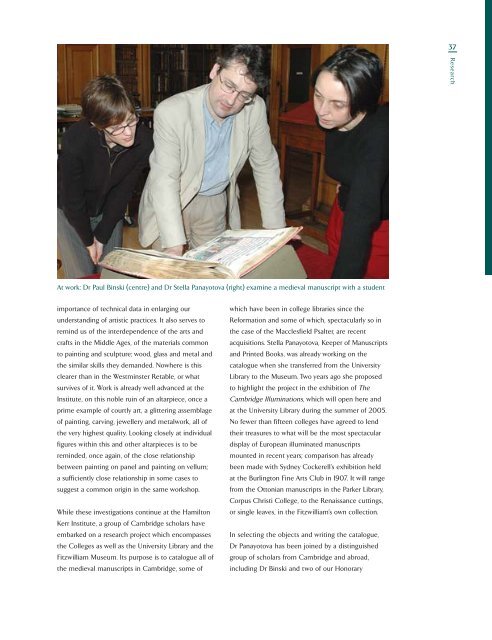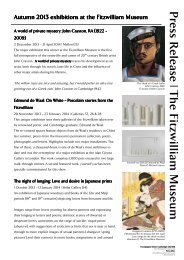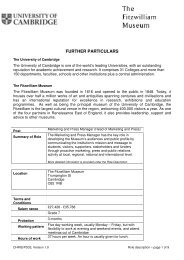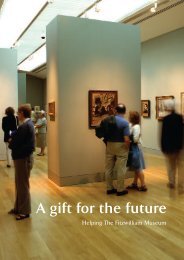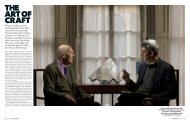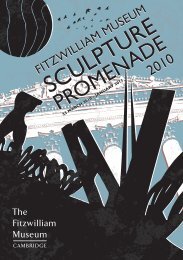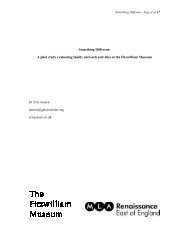The Fitzwilliam Museum - University of Cambridge
The Fitzwilliam Museum - University of Cambridge
The Fitzwilliam Museum - University of Cambridge
Create successful ePaper yourself
Turn your PDF publications into a flip-book with our unique Google optimized e-Paper software.
At work: Dr Paul Binski (centre) and Dr Stella Panayotova (right) examine a medieval manuscript with a student<br />
importance <strong>of</strong> technical data in enlarging our<br />
understanding <strong>of</strong> artistic practices. It also serves to<br />
remind us <strong>of</strong> the interdependence <strong>of</strong> the arts and<br />
crafts in the Middle Ages, <strong>of</strong> the materials common<br />
to painting and sculpture; wood, glass and metal and<br />
the similar skills they demanded. Nowhere is this<br />
clearer than in the Westminster Retable, or what<br />
survives <strong>of</strong> it. Work is already well advanced at the<br />
Institute, on this noble ruin <strong>of</strong> an altarpiece, once a<br />
prime example <strong>of</strong> courtly art, a glittering assemblage<br />
<strong>of</strong> painting, carving, jewellery and metalwork, all <strong>of</strong><br />
the very highest quality. Looking closely at individual<br />
figures within this and other altarpieces is to be<br />
reminded, once again, <strong>of</strong> the close relationship<br />
between painting on panel and painting on vellum;<br />
a sufficiently close relationship in some cases to<br />
suggest a common origin in the same workshop.<br />
While these investigations continue at the Hamilton<br />
Kerr Institute, a group <strong>of</strong> <strong>Cambridge</strong> scholars have<br />
embarked on a research project which encompasses<br />
the Colleges as well as the <strong>University</strong> Library and the<br />
<strong>Fitzwilliam</strong> <strong>Museum</strong>. Its purpose is to catalogue all <strong>of</strong><br />
the medieval manuscripts in <strong>Cambridge</strong>, some <strong>of</strong><br />
which have been in college libraries since the<br />
Reformation and some <strong>of</strong> which, spectacularly so in<br />
the case <strong>of</strong> the Macclesfield Psalter, are recent<br />
acquisitions. Stella Panayotova, Keeper <strong>of</strong> Manuscripts<br />
and Printed Books, was already working on the<br />
catalogue when she transferred from the <strong>University</strong><br />
Library to the <strong>Museum</strong>. Two years ago she proposed<br />
to highlight the project in the exhibition <strong>of</strong> <strong>The</strong><br />
<strong>Cambridge</strong> Illuminations, which will open here and<br />
at the <strong>University</strong> Library during the summer <strong>of</strong> 2005.<br />
No fewer than fifteen colleges have agreed to lend<br />
their treasures to what will be the most spectacular<br />
display <strong>of</strong> European illuminated manuscripts<br />
mounted in recent years; comparison has already<br />
been made with Sydney Cockerell’s exhibition held<br />
at the Burlington Fine Arts Club in 1907. It will range<br />
from the Ottonian manuscripts in the Parker Library,<br />
Corpus Christi College, to the Renaissance cuttings,<br />
or single leaves, in the <strong>Fitzwilliam</strong>’s own collection.<br />
In selecting the objects and writing the catalogue,<br />
Dr Panayotova has been joined by a distinguished<br />
group <strong>of</strong> scholars from <strong>Cambridge</strong> and abroad,<br />
including Dr Binski and two <strong>of</strong> our Honorary<br />
37<br />
Research


